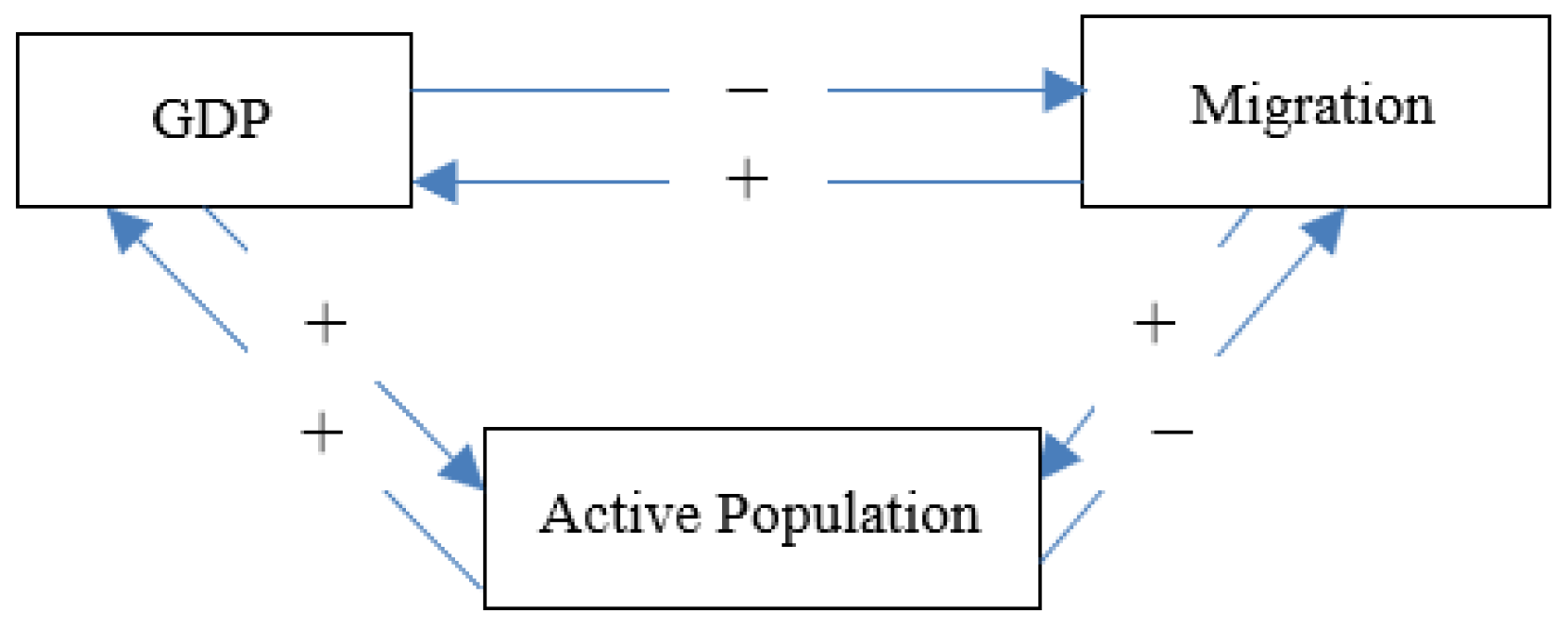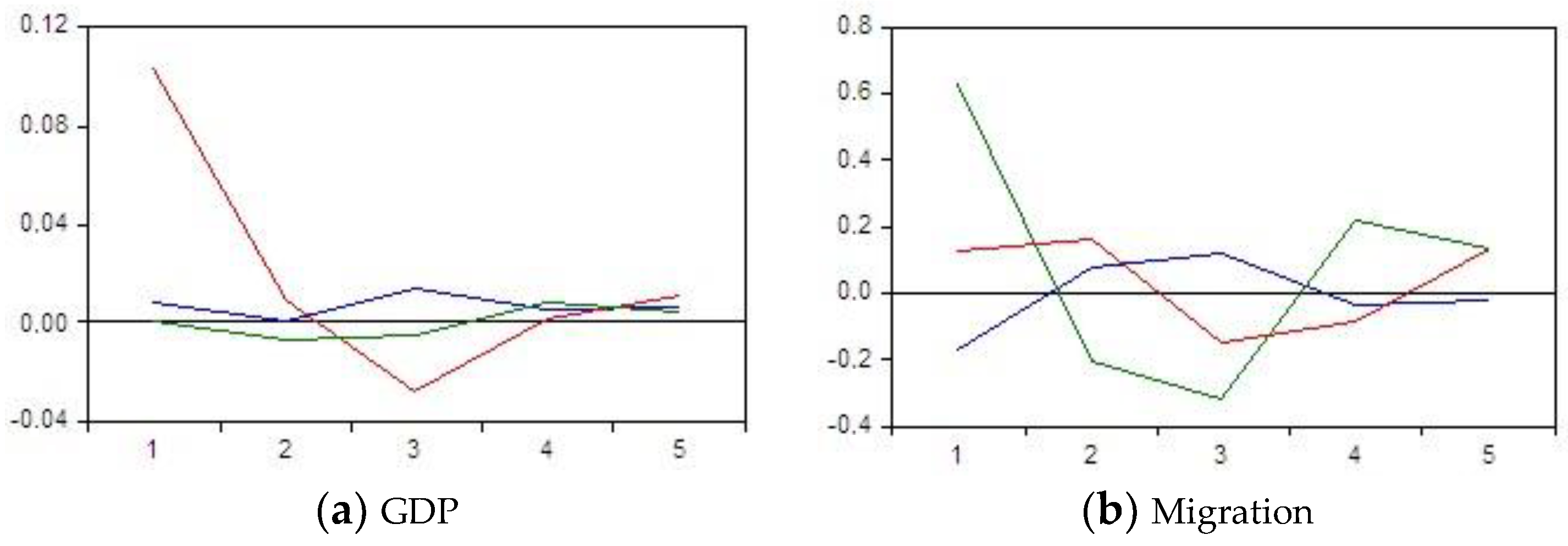Impact of Migration Processes on GDP †
Abstract
1. Introduction to the Migration Process
1.1. Analysis of References to the Current Migration Processes in Europe and the Impact of Migration on GDP
1.2. Literature Review
1.3. Three Types of Migration
- (i)
- Labor migration;
- (ii)
- Educational migration;
- (iii)
- Refugee migration.
2. Mathematical Tools for Studying the Impact of Migration on GDP
2.1. Methodological Aspects of Model-Building
2.2. Mathematical Models of Migration’s Influence on GDP
- (i)
- General VAR model and determination of the migration impact lag structure.
- (ii)
- Estimation of the lag’s influence in the VAR model. Generally, two main criteria exist for the determination of the lag’s influence; these are the Akaike criteria and the Schwarz criteria. We also used a Granger causality test for determining the lag structure.
- (iii)
- Impact impulse analysis. We used momentum analysis to determine the percentage impact of each factor on GDP. Decomposition analysis will help us to determine the part of the variance that depends on the changing pattern of the exogenous factors.
3. Model Design and Impact
3.1. Estimation of the Model’s Parameters
3.2. Impact of the Models
4. Conclusions and Future Prospects
- (i)
- The migration process is a complex scenario consisting of three components (labor migration, educational migration, and refugee migration) that have a cumulative impact on GDP and can change the structure of the country’s economically active population.
- (ii)
- We have built VAR models that characterize the impact of the following indicators on GDP: migration (I), interest rate (IR), active population (AP), exports (E), and the consumer price index (CPI). The Granger causality test made it possible to find such exogenous factors as GDP, migration, and the active population. This test also shows us that migration negatively affects the active population and positively affects GDP, while GDP growth leads to a decrease in migration.
- (iii)
- Impulse and decomposition analyses show that migration and GDP have cross-influences of about 10% and 14%. Migration has the most significant and stable impact on GDP. In addition, the population does not immediately respond to the deterioration of the economy in the country, and migration begins to increase with a decrease in GDP in the second year. Based on the above decomposition analysis, it is clear that migration into the country leads to an increase in GDP, and an increase in GDP leads to a decrease in migration out of the country.
Author Contributions
Funding
Informed Consent Statement
Data Availability Statement
Conflicts of Interest
References
- How Many Ukrainians Are Left? Who Will Not Return? What Will Ukrainian Society and Economy Be Like? Interview with Sociologist Ella Libanova. Available online: https://forbes.ua/war-in-ukraine/skilki-zalishilos-ukraintsiv-khto-ne-povernetsya-yakim-bude-ukrainske-suspilstvo-ta-ekonomika-intervyu-z-sotsiologineyu-elloyu-libanovoyu-17012023-11104 (accessed on 9 March 2023).
- An Official Website of the European Union. Homepage. Available online: https://www.eeas.europa.eu/eeas/migration-key-element-our-foreign-policy_en (accessed on 9 March 2023).
- Frontex-European Border a;nd Coast Guard Agency Homepage. Available online: https://frontex.europa.eu/media-centre/news/news-release/frontex-stands-with-ukraine-koMhlh (accessed on 17 March 2023).
- Brynjolfsson, E.; Diewert, W.E.; Eggers, F.; Fox, K.J.; Gannamaneni, A. The Digital Economy, GDP and Consumer Welfare: Theory and Evidence. 2018. Available online: https://www.oecd.org/naec/Brynjolfsson_MOCE-GDP-B_OECD_2018-07-26.pdf (accessed on 12 March 2023).
- Martin, F. Underestimating the Real Growth of GDP, Personal Income, and Productivity. J. Econ. Perspect. 2017, 31, 145–164. [Google Scholar]
- Cervellati, M.; Sunde, U. Life Expectancyand Economic Growth: The Role of Demographic Transition. Available online: https://docs.iza.org/dp4160.pdf (accessed on 12 March 2023).
- Woo, J.; Kumar, M.S. Public Debt and Growth. Available online: https://www.imf.org/external/pubs/ft/wp/2010/wp10174.pdf (accessed on 12 March 2023).
- Upreti, P. Factors Affecting Economic Growth in Developing Countries. Major Themes Econ. 2015, 17, 37–54. [Google Scholar]
- Labra, R.; Rock, J.A.; Álvarez, I. Identifying the key factors of growth in natural resource-driven countries. A look from the knowledge-based economy. Ens. Sobre Politics Econ. 2016, 34, 74–89. [Google Scholar] [CrossRef]
- Report of the United Nations Development Program (UNDP), published on 21 October 2020. Available online: https://news.un.org/ru/story/2020/10/1388792 (accessed on 17 April 2023).
- Heinisch, K.; Wohlrabe, K. The European Refugee Crisis and the Natural Rate of Output, IWH Discussion Papers, No. 30/2016, Leibniz-Institut für Wirtschaftsforschung Halle (IWH). 2016. Available online: https://www.researchgate.net/publication/260096281_Theories_and_Typologies_of_Migration_An_Overview_and_A_Primer (accessed on 7 May 2023).
- Kudaeva;, M.; Redozubov, I. The Impact of Migration Flows on Economic Activity and the Labor Market of Russia in General and in the Regional Aspect. 2021. Available online: http://www.cbr.ru/statichtml/file/131869/wp_khab_dec.pdf (accessed on 20 April 2023).
- Zhuravskaya, K. Statistical Analysis of the Factors Shaping the GDP. Agro-Food Economics. 2016. Available online: http://apej.ru/article/04-04-16 (accessed on 20 April 2023).
- Kira, A.R. The Factors Affecting Gross Domestic Product (GDP) in Developing Countries: The Case of Tanzania. Eur. J. Bus. Manag. 2013, 5, 4. Available online: www.iiste.org (accessed on 27 April 2023).
- Guo, H.; Zhang, Z. An Empirical Study of Factors Influencing Australia’s GDP. In Proceedings of the 2022 International Conference on Mathematical Statistics and Economic Analysis (MSEA 2022), Dalian, China, 27–29 May 2023; pp. 581–586. [Google Scholar]
- Ribaj, A.; Mexhuani, F. The impact of savings on economic growth in a developing country (the case of Kosovo). J. Innov. Entrep. 2021, 10, 1. [Google Scholar] [CrossRef]
- Nketiah, E.; Cai, X.; Adjei, M.; Boamah, B.B. Foreign Direct Investment, Trade Openness and Economic Growth: Evidence from Ghana. Open J. Bus. Manag. 2020, 8, 39–55. [Google Scholar] [CrossRef]
- International Migration: Drivers, Factors and Megatrends (2020). International Centre for Migration Policy Development (ICMPD). Available online: https://www.icmpd.org/file/download/51472/file/Policy%2520Paper%2520-%2520Geopolitical%2520Outlook%2520on%2520International%2520Migration.pdf (accessed on 1 May 2023).
- Courtney, B.; Dustmann, C.; Preston, I. The Labor Market Integration of Refugee Migrants in High-Income Countries. J. Econ. Perspect. 2020, 34, 94–121. [Google Scholar]
- Pew Research Center. Around the World, More Say Immigrants Are a Strength Than a Burden; Spring 2018 Global Attitudes Survey: Washington, DC, USA, 2019. [Google Scholar]
- Worldwide Immigration Trends Report. Available online: https://www.fragomen.com/trending/worldwide-immigration-trends-reports/index.html?gclid=CjwKCAjw6vyiBhB_EiwAQJRopmEjn5ZEkMbLRGrxitYEGUwnsobcCGZhu6Gzj1_enqquuQ0euA7YnBoChlYQAvD_BwE (accessed on 27 April 2023).
- World Migration Report 2022. International Organization for Migration. Available online: https://worldmigrationreport.iom.int/wmr-2022-interactive (accessed on 27 April 2023).
- An Official Website of the Eurostat. Homepage. Available online: https://ec.europa.eu/eurostat (accessed on 27 March 2023).
- An Official Website of the State Statistics Service of Ukraine. Homepage. Available online: https://www.ukrstat.gov.ua/ (accessed on 12 March 2023).



| Series | t-Stat | Prob. |
|---|---|---|
| DLOG_AP | −9.5662 | 0.0000 |
| DLOG_CPI | −9.1768 | 0.0000 |
| DLOG_E | −6.1593 | 0.0000 |
| DLOG_GDP | −4.9360 | 0.0004 |
| DLOG_I | −6.8486 | 0.0000 |
| DLOG_IR | −3.6155 | 0.0532 |
| LOG_AP | −1.9639 | 0.3001 |
| LOG_CPI | −2.2329 | 0.1995 |
| LOG_E | −1.0199 | 0.7307 |
| LOG_GDP | −2.1610 | 0.2237 |
| LOG_I | −1.7057 | 0.4186 |
| LOG_IR | 0.7998 | 0.9920 |
| DLOG_AP-Chi-sq | 24.274920 | 0.0009 |
| DLOG_CPI-Chi-sq | 11.16410 | 0.3449 |
| DLOG_E-Chi-sq | 14.51292 | 0.1509 |
| DLOG_GDP-Chi-sq | 24.51292 | 0.0015 |
| DLOG_I-Chi-sq | 26.725775 | 0.0007 |
| DLOG_IR-Chi-sq | 5.386847 | 0.8639 |
| DLOG_AP | DLOG_GDP | DLOG_I | |
|---|---|---|---|
| DLOG_AP(−1) | 0.454114 | 3.512704 | −8.771671 |
| DLOG_AP(−2) | 0.537753 | 6.638702 | 27.09934 |
| DLOG_GDP(−1) | 0.008067 | 0.290427 | −3.008223 |
| DLOG_GDP(−2) | −0.004253 | −0.233841 | 0.799000 |
| DLOG_I(−1) | −0.000387 | 0.012125 | −0.301089 |
| DLOG_I(−2) | −0.000335 | 0.001815 | −0.497146 |
| C | −0.000643 | −0.022083 | −0.689128 |
| DLOG_CPI | 0.004353 | −0.209005 | 1.500807 |
| DLOG_E | −0.011102 | 1.080142 | −4.583303 |
| DLOG_IR | −0.000654 | −0.018509 | 0.271095 |
| R-squared | 0.891028 | 0.737911 | 0.891095 |
| AkaikeAIC | −8.616383 | −7.571587 | 8.443811 |
| SchwarzSC | −8.132499 | −7.087704 | 8.927694 |
| Akaike information criterion | −7.859639 | ||
| Schwarz criterion | −6.407989 | ||
| Variance decomposition of Migration | ||||
| Period | S.E. | DLOG_AP | DLOG_GDP | DLOG_I |
| 1 | 0.002826 | 6.569453 | 0.0000046 | 93.43054 |
| 2 | 0.003244 | 6.558724 | 12.37724 | 81.06403 |
| 3 | 0.003836 | 7.065201 | 11.46494 | 81.46986 |
| 4 | 0.004250 | 6.569463 | 14.29596 | 79.13457 |
| 5 | 0.004671 | 6.393239 | 14.94129 | 78.66547 |
| Variance decomposition of GDP | ||||
| Period | S.E. | DLOG_AP | DLOG_GDP | DLOG_I |
| 1 | 0.095695 | 4.641632 | 85.35837 | 10.00000 |
| 2 | 0.099833 | 4.294604 | 85.00568 | 10.69971 |
| 3 | 0.102142 | 4.686875 | 84.60249 | 10.71063 |
| 4 | 0.102684 | 4.739765 | 84.15611 | 11.10412 |
| 5 | 0.103043 | 5.094311 | 83.78465 | 11.12104 |
Disclaimer/Publisher’s Note: The statements, opinions and data contained in all publications are solely those of the individual author(s) and contributor(s) and not of MDPI and/or the editor(s). MDPI and/or the editor(s) disclaim responsibility for any injury to people or property resulting from any ideas, methods, instructions or products referred to in the content. |
© 2023 by the authors. Licensee MDPI, Basel, Switzerland. This article is an open access article distributed under the terms and conditions of the Creative Commons Attribution (CC BY) license (https://creativecommons.org/licenses/by/4.0/).
Share and Cite
Rayevnyeva, O.; Stryzhychenko, K.; Matúšová, S. Impact of Migration Processes on GDP. Eng. Proc. 2023, 39, 86. https://doi.org/10.3390/engproc2023039086
Rayevnyeva O, Stryzhychenko K, Matúšová S. Impact of Migration Processes on GDP. Engineering Proceedings. 2023; 39(1):86. https://doi.org/10.3390/engproc2023039086
Chicago/Turabian StyleRayevnyeva, Olena, Kostyantyn Stryzhychenko, and Silvia Matúšová. 2023. "Impact of Migration Processes on GDP" Engineering Proceedings 39, no. 1: 86. https://doi.org/10.3390/engproc2023039086
APA StyleRayevnyeva, O., Stryzhychenko, K., & Matúšová, S. (2023). Impact of Migration Processes on GDP. Engineering Proceedings, 39(1), 86. https://doi.org/10.3390/engproc2023039086







